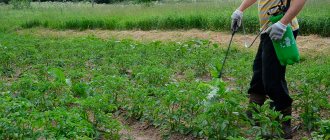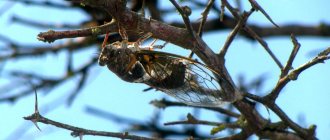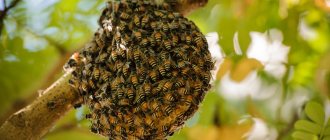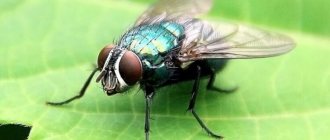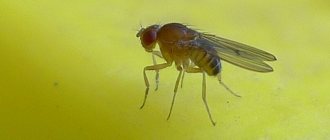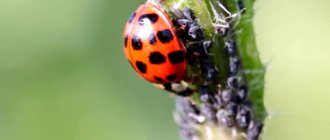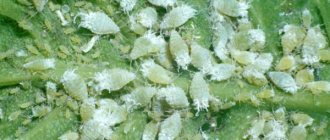Perennial tuberous dahlias with a height of 60 cm to 1.2 m are very impressive for growing, both in single plantings and in flower beds. There are compact dwarf dahlias with small inflorescences, which are placed in rock gardens, containers and flower beds.
Dahlias are flowers that bloom in autumn, starting in the second half of summer, from July to October. Dahlias reproduce by dividing tubers or cuttings.
It is necessary to divide dahlia tubers before planting in open ground in spring:
- This rejuvenates the bush;
- Undivided root tubers produce too many sprouts. The bush grows dense, with a large number of thin and weak young shoots. There will be few buds and flowers.
- Dividing dahlias is an excellent way to propagate varietal plants.
Dividing dahlia tubers
Propagation of dahlias by dividing tubers is the most common and least labor-intensive method. The advantage of this method of propagation is the prevention of aging of the culture.
How and when to divide tubers
The division procedure is carried out as desired: in the fall during the preparation of planting material for storage or in the spring immediately before germination. Dividing tubers in the fall may seem difficult for beginners, since the root buds in the embryonic phase are practically not visible.
In this case, it is better to postpone dividing the tubers until spring, when the buds begin to sprout. But you can use a little trick: in the fall, two weeks before digging up the bush, cut off the stem. This will provoke the growth of the buds, they will become more noticeable. The buds are located, as a rule, along the circumference of the stem, on the upper section of the tuber.
Experienced gardeners prefer autumn division, explaining this fact:
- better preservation of planting material;
- ease of working with the material - the tubers have not yet hardened and have an elastic skin;
- in the fall there is enough time to work with tubers - you can carry out a thorough inspection and processing of the cuts;
- saving time in the spring to do other work in the garden.
Dahlias are dug up with stable sub-zero temperatures established. For most regions, this period falls in the second half of October - the first half of November. You can tell when it’s time to dig up dahlias by looking at a wilted or slightly frozen stem; the flowering period should be completely over by this point.
Dig up dahlias at a distance of 25 cm - 35 cm from the root, around the circumference. This technique allows you to trim long root shoots without damaging the tuber itself.
Next, the plant is laid on its side to turn the rhizome over, allowed to dry for several hours, and brought into a warm room, where the tuber is divided. The algorithm of actions is as follows:
- The stems are cut, leaving shoots no longer than 2 cm - 3 cm; a larger length will lead to rotting and damage to the tubers during storage.
- The tubers are washed with running water; careful treatment will eliminate subsequent infection by infections and pests that are in the soil.
- Dead tubers, long suction roots, and any dried and flaccid parts of the rhizome are removed.
- Parts that are too light and thin are removed, as they are not shelf-stable and will not produce shoots in the spring.
- All rusty and yellow spots are cut out; discoloration of the neck also indicates damage to the plant.
- The tubers are separated with a sharp, disinfected knife. Disinfection of the instrument is carried out for each excavated rhizome (group of tubers).
- The separated tubers are washed again to avoid infection during storage.
You can check the viability of dahlia tubers by placing them in water. The floating tubers are discarded. Heavy tubers that have sunk to the bottom are prepared for storage.
In spring, tubers are taken out of storage 14–20 days before planting and inspected. The main sign that the tubers are ready for the division procedure is the awakening of the buds. If the buds (flower growers call them eyes) are not yet visible, the tubers are sprayed with water and placed in a lighted place for germination at an air temperature of +18°C - +23°C. Instead of water, industrial growth activators can be used.
After about two weeks, the tubers are divided using the same algorithm as in the fall. It is desirable that each separated tuber have several eyes.
Processing slices
Before storing for winter storage, tubers with fresh cuts are treated with systemic fungicides or a sulfur preparation according to the instructions. The tubers are soaked in the solution for 15 minutes, dried and placed in storage. The same is done after germination of tubers in the spring before planting.
Some gardeners add insecticides to fungicides to eliminate the risk of pest infestation. Even with the most careful inspection, you may miss an insect larva.
In cases where there are no special means at hand, and you need to act quickly, a solution of pharmaceutical manganese is used.
Site selection and preparation
Heat-loving dahlias are easily damaged even by minor frosts, so lowlands with stagnant moisture and poor air circulation are not suitable for them. They grow best on flat or elevated areas where there are no through winds - the fragile stems break in strong winds.
It is not recommended to plant them next to buildings, fences, or close to tall trees, since lack of light (less than 6 hours a day) causes the flowers to become smaller and the color richness is lost. In areas where the groundwater level is less than 1 m, moisture stagnation is observed, the tubers begin to hurt, the supply of nutrients is disrupted, and the bush dies. In this case, if there is no choice, high embankment ridges are built.
The place for the ridges, flower beds are prepared in the fall - they dig them up (depth 30-35 cm), add rotted manure (10-15 kg/1 m²), potassium sulfate and superphosphate (1 tbsp./1 m²). In May, when there are 2-3 weeks left before planting, they dig again, but to a depth of 20-25 cm, adding wood ash (2-3 tbsp), Agricola and urea (1 tbsp each) per square area. .
Ways to improve the structure and composition of the soil:
- if the soil is heavy and dense, then coarse sand is added when digging - it will make the soil more loose and breathable;
- sandy ones are “weighted” with peat, vermiculite, clay - they retain moisture well;
- for alkaline ones add a little peat, for acidic ones (pH 4-5) - slaked lime powder (0.3-1 kg/1 m²) or chalk, dolomite flour.
Since lime slows down the growth of beneficial bacteria necessary for the decomposition of organic matter, lime and organic matter cannot be added together. Organic matter is added in the fall, and lime in the spring. Nitrogen and potassium fertilizers are quickly washed out of the soil, so they are added when digging and into the planting hole.
Cuttings
Cuttings are considered the most productive method of propagation, because from one dahlia you can get 35 - 45 cuttings, each of which will become an independent plant in the future.
Cuttings have a number of advantages over tuberous propagation of dahlias:
- in the process of taking cuttings, early culling of planting material is carried out, whereas when propagated by tubers, a diseased plant can be identified only at the stage of emergence;
- dahlias from cuttings increase their vegetative mass and bloom earlier;
- dahlias removed from cuttings have higher immunity;
- dahlias from cuttings better retain their species characteristics and are distinguished by the purity of the variety;
- flowers have more lush and abundant flowering.
True, there are also disadvantages to propagation by cuttings. Due to the peculiarities of germination technology, the plant’s tubers are deformed, the root shoots are bent and intertwined. Several shoots always appear from the tuber, even if it is damaged. An injured cutting never survives.
The number of tubers and their size in a cutting dahlia is much smaller than in a flower planted by dividing the tubers. In addition, cuttings are a rather complicated method, especially for beginners. Propagation by tubers is easier, but the quality of the resulting plants is often worse.
Timing for planting queen cells on cuttings
Royal tubers are planted in winter, around the first ten days of February. The timing of the work must be calculated in such a way that the rooting period of the cuttings occurs no earlier than mid-March. It is from the second half of March until the beginning of July that cuttings take root best.
At the preparatory stage, containers and instruments are prepared: washed with a soda solution, disinfected either by sterilization or using an alcohol solution. The mother tubers are sorted and the highest quality ones are selected.
Preparing the substrate and preparing the queen cells
The soil mixture for royal tubers is prepared in the fall. This can be fertile garden soil, to which a little peat is added. If the soil has not been stocked since the fall, it will have to be purchased at the store. An important point is to disinfect the soil before planting. Purchased soil may not be processed, but garden soil may contain weed seeds, pathogenic flora and pest larvae.
There are several ways to treat the soil, the simplest and most effective of which is freezing. To do this, the soil is left on the loggia or in the courtyard at low temperatures for several weeks.
A more labor-intensive method is steaming in a water bath. Containers with soil mixture are placed on a pan of boiling water and kept for several hours. The advantage of the method is the preservation of beneficial microorganisms and the destruction of pathogenic ones.
Calcination in the oven is an old method that has long since exhausted its usefulness. Calcined soil is depleted and dehydrated, there is no pathogenic flora in it, but beneficial microorganisms will also completely die.
Among modern methods, we can recommend treating the soil with biologically active preparations, which can be purchased in specialized stores.
Royal tubers are placed in a lighted place. If there is not enough light, additional lighting is carried out with lamps. Before this, the tubers are treated with fungicides or a low concentration manganese solution. To accelerate the awakening of tubers, growth stimulants and activators are used, for example, the drug "Epin".
If you buy queen cells in a store, select clean tubers without traces of putrefactive lesions and root shoots. They should not be too light or small.
Queen cells are planted in two ways:
- Single planting in a container 10 cm – 20 cm high.
- Group planting in a container.
When planting individually, it is necessary to ensure that the neck of the queen cell is above the level of the soil mixture. When planting in groups, the queen cells are placed in a horizontal position. The second method is less labor-intensive, but has a drawback: the roots of the tubers can get tangled.
The optimal temperature for germination of mother tubers is +20°C – +25°C. The soil should not be allowed to dry out. After about three weeks, young shoots appear, and preparations for cuttings can begin.
With the appearance of the first shoots, the conditions for keeping the mother tubers change. Watering is reduced, and the temperature drops to +18°C – +21°C.
Pots for cuttings
For rooting cuttings, small containers with a height of 15 cm and a diameter of no more than 10 cm are used. Since dahlia is a heat-loving crop, greenhouse conditions are created for the cuttings. To do this, you need to prepare glass jars that will be used as a cap. Instead of glass jars, you can use cut plastic bottles or drinking water tanks.
To root cuttings, you can purchase a home mini-greenhouse. It consists of a plastic tray with high sides, into which cassettes with soil and cuttings are placed. The top of the device is covered with a voluminous lid. The greenhouse is easy to use and designed for reusable use. Only the plant cassettes will require replacement.
Caring for cuttings
Cuttings are performed when the shoots on the mother plant (usually there are two) reach 7 cm - 10 cm. They are cut at an angle with a clean tool: a kitchen or stationery knife. After cutting, a few millimeters of shoot should remain at the base of the queen cell; in this case, forcing the cuttings will continue continuously. Each cutting is buried in a well-moistened soil substrate, after which it is necessary to take care of the growing conditions.
Spraying and watering
During the period when the cuttings are in greenhouse conditions, it is necessary to monitor the level of soil moisture. The soil should not be allowed to dry out, as waterlogging will lead to the development of fungal diseases. To prevent the appearance of fungus, airing is carried out daily, for which the lids are removed from the containers for half an hour.
To speed up rooting, before planting, the cuttings are dipped in a solution of the drug “Kornevin” or in a self-prepared solution: 5 ml of honey/100 ml of aloe juice/1 liter of water.
Temperature and light mode
The cuttings will need additional illumination with fluorescent lamps for two hours in the morning and evening hours. The optimal temperature during the rooting period is +20°C. After approximately 10 - 12 days, the first roots appear on the cuttings. At this time, the greenhouse caps must be removed so that the planting material can adapt to room conditions. With the onset of active growth, the plants are transplanted into larger containers, and after 10 ten days the first mineral fertilizer is applied.
Tools
Before dividing dahlias in the fall, let’s arm ourselves with these tools and other necessary things:
- We will need a sharp pruning shears.
- It needs an equally sharp knife to pair it with. Of course, it is better to use a garden one. In the absence of one, a kitchen knife will cope with the task.
- Potassium permanganate - for disinfecting tubers.
- A container in which disinfection will take place and clean, cool water.
- Also prepare identification tags with the names of the varieties.
- Take out regular plastic bags.
Propagation by seeds
Reproduction of dahlias by seeds is carried out to obtain new specimens with the exception of preserving species characteristics from the perennial mother bush. Annual crops of dark-leaved and dwarf species are also bred with seeds.
We prepare seeds
If the goal is to obtain a new variety of dahlias, the seeds are purchased at the store. Most often, they are already prepared for planting and etched with special solutions in industrial conditions. All that remains is to soak the seeds and plant them in containers.
If you want to get a variety that is already in the garden, you can prepare the seeds. For this, inflorescences with almost ripe seeds are cut off and left to ripen (ripen) in a dry and warm room. After ripening, the seeds are removed, dried and packaged for storage until March, when planting will take place.
Preparing soil and pots for planting seeds
In the northern regions and central zone, dahlias are grown as seedlings. Containers are prepared for seedlings and filled with sandy loam soil. Sprinkle the planted seeds with a layer of sand, which is disinfected in advance by calcination.
With the appearance of one or two true leaves, the seedlings are picked in separate containers with a height of 15 cm - 20 cm and a diameter of 8 cm - 10 cm. Picking can also be carried out in spacious boxes, maintaining a distance between plants of at least 7 cm. Nutrient soil is prepared in the container for picking from loamy soil, humus and sand in a ratio of 2:2:1.
Before planting, the seeds are pickled in a manganese solution for 15 minutes, then washed and quickly planted. Embedding into the soil is carried out to a depth of 5 mm - 1 cm.
Planting and caring for crops
After picking, the seedlings are fed with complex fertilizers. Flowers are kept in pots until May, and only after that they are transferred to a greenhouse before the end of the month. This is due to the fact that sub-zero temperatures are destructive for dahlias; they simply will not survive the return of spring frosts.
From mid-June, dahlias are planted in open ground. At this time, the plants are already beginning to budding, but the crop tolerates replanting when the temperature stabilizes.
Standard care for dahlias includes:
- moderate and regular watering;
- loosening and timely removal of weeds;
- fertilizing;
- pinching - pinching shoots to form a bush.
Ten days after planting and before flowering, fertilizers are applied to the dahlias every two weeks. Considering the late date of planting in open ground, fertilizing begins at the stage of growing in pots during the period of active growth.
Organic solutions from mullein or chicken droppings are added. For abundant flowering, nitrogen fertilizers are applied to dahlias: urea or ammonium nitrate. Experienced gardeners recommend alternating organic and mineral fertilizers to obtain maximum results.
Pruning of bushes is carried out immediately after the plant has adapted to a permanent place and until the end of the growing season. All side shoots and part of the buds are pinched. The flower stalk of dahlias usually consists of three inflorescences, from which the bud on the shortest stem is removed. The lower leaves are also removed to provide light access to the tubers.
Rejection of dahlias planted with seeds is carried out in the first season. Usually, out of a hundred plants, no more than five remain worthy of bearing the name of the variety.
Rules for planting in the ground
There are no uniform dates for planting dahlias in the ground - they depend on the weather. The main condition is well-warmed soil, constant positive daytime temperatures, and the absence of frosts that are destructive for tender sprouts.
How to plant:
- dig holes with a depth of 20 to 30 cm, the distance between them is at least 0.5 m;
- pour humus (1/3-1/4 bucket), ash (1 cup), superphosphate (2 tbsp) into each, mix;
- pour in 5-6 liters of water, wait until completely absorbed;
- place a division at the bottom with the sprouts facing up, cover it - the sprout remains at soil level or slightly protrudes above the surface.
If there is no natural organic matter, then humus will be replaced by nitrophoska, urea, ash - potassium sulfate, potassium nitrate. Dilute according to fertilizer instructions.
Reproduction of dahlias by stepsons
Reproduction by stepsons is a method rarely used in dahlias. The correct name is propagation by sports, but since the lateral branches are taken for the procedure, this name has stuck. The method is used to breed new types of dahlias.
An unusual branch is found on the bush, with characteristics atypical for this variety. These branches are called sports. From the sport, cut a stalk 9 cm - 12 cm long and plant it in a pot with moistened soil. Since sports usually appear at the end of the growing season, the cuttings are overwintered in a pot at home.
In order for the plant to go into winter, watering is gradually reduced from the end of October, and increased again in February. In March, nitrogen fertilizing is carried out, and dahlias obtained from cuttings or tubers are planted in open ground.
There are several ways to propagate dahlias, they all have their advantages and disadvantages. But whatever method you prefer, remember that dahlias are responsive plants; they will definitely respond to your care with abundant flowering.

